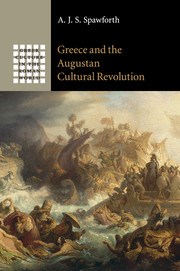Book contents
- Frontmatter
- Contents
- Illustrations
- Acknowledgments
- Chapter 1 Introduction
- Chapter 2 ‘Athenian eloquence and Spartan arms’
- Chapter 3 ‘The noblest actions of the Greeks’
- Chapter 4 ‘The gifts of the gods’
- Chapter 5 ‘Constructed beauty’
- Chapter 6 Hadrian and the legacy of Augustus
- Conclusion
- Bibliography
- Index
- References
Chapter 2 - ‘Athenian eloquence and Spartan arms’
Published online by Cambridge University Press: 05 November 2011
- Frontmatter
- Contents
- Illustrations
- Acknowledgments
- Chapter 1 Introduction
- Chapter 2 ‘Athenian eloquence and Spartan arms’
- Chapter 3 ‘The noblest actions of the Greeks’
- Chapter 4 ‘The gifts of the gods’
- Chapter 5 ‘Constructed beauty’
- Chapter 6 Hadrian and the legacy of Augustus
- Conclusion
- Bibliography
- Index
- References
Summary
‘Every state has its peculiar glory. Athens is famous for eloquence, Thebes for religion, Sparta for arms.’ This Roman stereotype of the ‘true Greece’ comes in the form of a sententia or ‘pointed saying’ from a declamation on the theme of Leonidas and Thermopylae performed in Augustan Rome by the rhetor Cestius Pius, of whom more in due course. This chapter explores two interventions in Greece by, respectively, Augustus and his son-in-law Agrippa which responded to, and consolidated, these Roman images of an idealised Athens and Sparta. Recent scholarship, repeatedly drawn on in this book, offers valuable interpretations of Augustan activity in Greece, and Athens in particular, much of it based on archaeological and art-historical evidence. These two episodes, however, provide the only really firm basis for the historical reconstruction of Augustan cultural initiatives in the two most famous cities of contemporary Greece.
Athens: the agrippeum
Augustus is sometimes credited with a ‘building programme’ in Athens. In fact, the only Athenian monuments which can be attributed to his regime with complete confidence are, firstly, the so-called Roman Agora, a complex begun with funds from Julius Caesar and therefore not, strictly speaking, an Augustan initiative, and, secondly, the performance space known to Philostratus in his Lives of the Sophists as the Agrippeum. American archaeologists have firmly identified this structure with a massive building of Augustan date in the centre of the Athenian agora proper.
- Type
- Chapter
- Information
- Greece and the Augustan Cultural Revolution , pp. 59 - 102Publisher: Cambridge University PressPrint publication year: 2011



